- Scientific name: Viola selkirkii Pursh ex Goldie
Species of Greatest Conservation Need (MA State Wildlife Action Plan)
Description
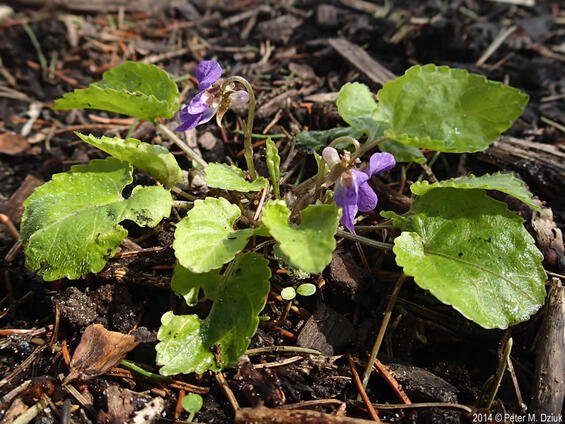
Photo credit: Peter M. Dziuk, MinnesotaWildflowers.info
Great-spurred violet, Viola selkirkii, is a perennial herbaceous woodland plant and a member of the violet family (Violaceae). Great-spurred violet is categorized as a “stemless violet” as it is clump forming and produces flowering stems and 2 to 12 leaves directly from its rhizome. Neither the leaves nor the flowers branch off of an upright stem. This species not only has distinctive flowers, but its leaves are also distinctive particularly later in the summer. The bilaterally symmetrical spring flowers have five pale blue to purple petals with no hairs within the flower. The throat of the violet is white and it has a thick spur behind the flower that is 4-7 mm (0.16-0.28 in) long and is club shaped. The flower produces nectar in this spur. The peduncle (stem attached to flowers) holds the spring flowers above the leaves. The ovate leaves have crenate (rounded teeth) margins with deeply cordate (heart shaped) bases, the inner edges of which often overlap each other, particularly by late summer. The undersides of the leaves and their petioles (leaf stem) are also hairless, while the dark green upper side of the leaves have scattered appressed hairs. The leaves measure 1-5 cm (0.4-2 in) long by 1-5 cm (0.4-2 in) wide and a rounded to acute tip. Violets produce a pair of leafy appendages at the base of their petioles called stipules. The stipules of great-spurred violet are linear-lanceolate with entire margins and are partway attached along the petiole.
Violets produce two kinds of flowers, ones which open (and described above) are insect-pollinated in the spring called chasmogamous and ones which are self-pollinated that appear mid-summer and never open which are called cleistogamous. The self-pollinated flowers in summer are produced by the base of the plant on much shorter peduncles and are egg-shaped and green colored, or white when covered by soil. Both flower types produce ellipsoid-shaped capsules measuring 4-8 mm (0.16-0.31 in) long, and contain small light orange-brown seeds, each measuring 1-2 mm (0.04-0.08 in). The capsules are green and dry to tan with purple spots or blotches.
While violets can be a challenging group of species to identify, great-spurred violet is relatively distinctive amongst species found in Massachusetts due to its long floral spur and leaf characteristics. Other species found in Massachusetts with a long spur include long-spurred violet (Viola rostrata), a native species listed on the Massachusetts watch list, and Japanese violet (Viola japonica), a non-native species which may escape from garden settings. Long-spurred violet is distinguished by its growth form, producing its leaves and flowers from an arial stem (it is a “stemmed” violet), whereas great-spurred violet produces its leaves and flowers directly from its rhizome on the ground. Japanese violet produces only basal leaves like great-spurred violet, but it produces a longer spur measuring 5-10 mm (0.2-0.4 in) and oblong to broad-lanceolate leaves, unlike great-spurred violet whose spur measures 4-6 mm (0.16-0.24 in) long and leaves are cordate-ovate.
Life cycle and behavior
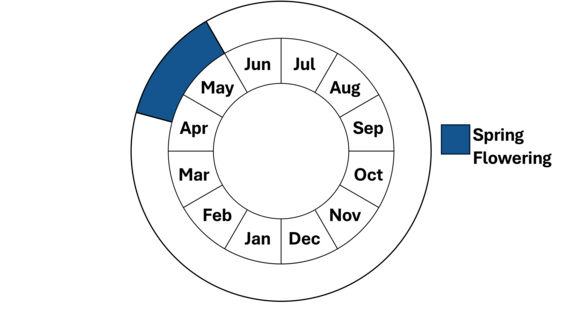
Great-spurred violet is a perennial species. It has spring flowers in Massachusetts in April or May that are pollinated by insects and produce fruit soon thereafter. The cleistogamous flowers appear in mid-summer and produce the self-pollinated capsules by early fall. Great-spurred violet capsules explode to eject its seeds (from both types of flowers) away from the parent plant where they are then retrieved by ants for the attached lipid rich elaiosomes and carried to new locations. After the elaiosomes are stripped from the seeds, the seeds are deposited in the ants’ compost, which is rich in organic material for the seeds to sprout. Although many violets are known to form hybrids with other species of violets, there are no known hybrids of great-spurred violet.
Population status
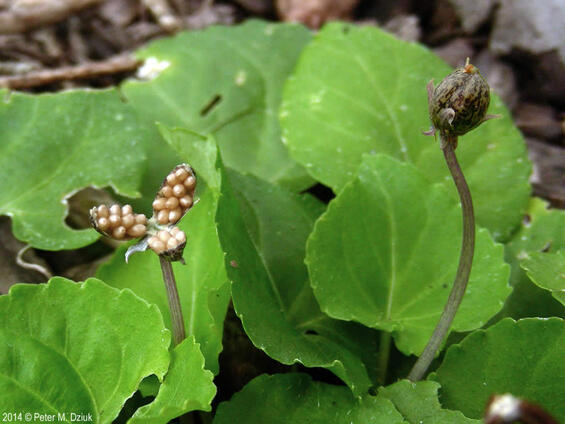
Photo credit: Peter M. Dziuk, MinnesotaWildflowers.info
Great-spurred violet has recently been elevated to a species of greatest conservation need and is maintained on the plant watch list. These are species that the state botanists are concerned might be decreasing or do not have sufficient information to rank. Great-spurred violet currently has only 5 known populations in Berkshire, Franklin, and Worcester Counties that have been observed since 1999 and reported to MassWildlife’s Natural Heritage and Endangered Species Program. Several historical populations have not been observed recently. It has only recently been included as a species of greatest conservation need. If you see any rare species, please report them through Heritage Hub.
Distribution and abundance
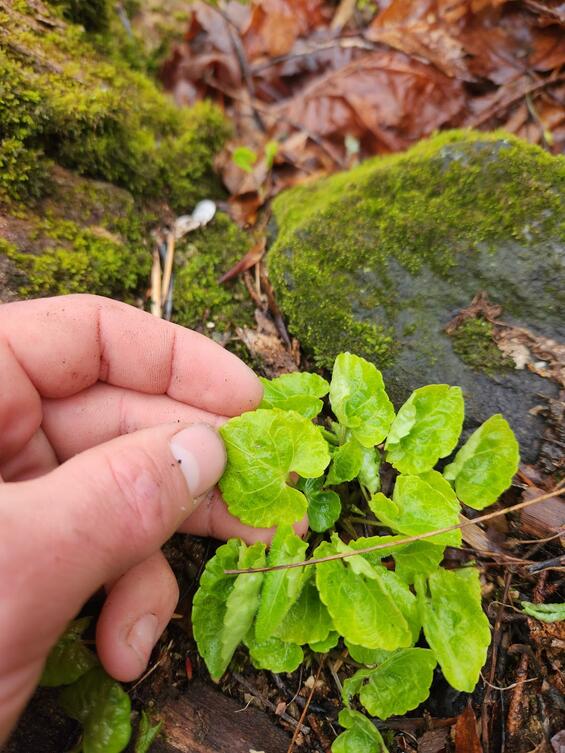
Photo credit: Matt Charpentier
Great-spurred violet is known throughout the northern portion of North America, from Newfoundland to Alaska, south to Idaho and Pennsylvania with disjunct populations in Colorado. New Mexico and South Dakota. In the United States great-spurred violet is of conservation concern in several states, including vulnerable in South Dakota; imperiled in Colorado and Montana; and critically imperiled in Connecticut, Idaho, and Massachusetts. It is not known from Rhode Island.
Habitat
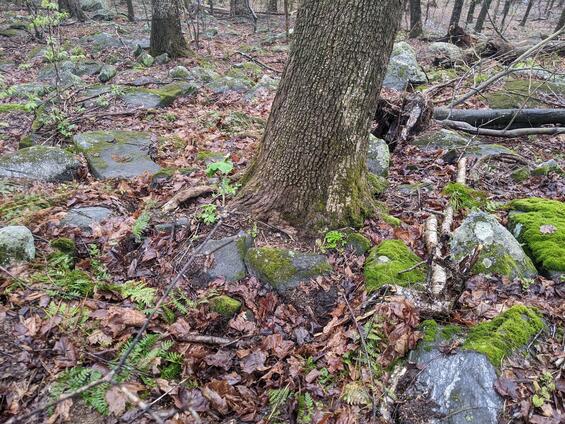
Photo credit: Matt Charpentier
In Massachusetts, great-spurred violet inhabits cool, rich moist rocky woodlands, typically in northern hardwood forests. Associated forests are composed of sugar maple (Acer saccharum), shagbark hickory (Carya ovata), red oak (Quercus rubra), basswood (Tilia americana), black birch (Betula lenta), hop hornbeam (Ostrya virginiana), and striped maple (Acer pensylvanicum).
Healthy habitats are vital for supporting native wildlife and plants. Explore habitats and learn about conservation and restoration in Massachusetts.
Threats
Great-spurred violet is close to its southeastern range extent in Massachusetts preferring cooler habitats, indicating it may be negatively impacted by a warmer climate (Staudinger et al. 2024). Another threat to great-spurred violet’s viability are increases in stormwater runoff which may erode suitable habitats. This could be caused by development uphill of its habitat, or by extreme increases in rainfall due to climate change. Climate change can also bring about longer periods of drought which may negatively impact these plants that require moist, rich soil. Ohkawara and Higashi (1994) determined that seeds of great-spurred violet experience up to 99% predation damage. In addition, if the ants that typically carry the seeds to new locations have population reductions, that will also negatively impact the violet. Logging within great-spurred violet habitat could have direct negative impact on plants and their habitat. Finally, invasive plant species growing within the habitat of great-spurred violet may shade and out-compete this violet.
Conservation
Sites where great-spurred violet was historically documented should be revisited to determine whether populations persist. Great-spurred violet can be identified throughout the growing season, though the best time is during April and May when it is in bloom. Populations of great-spurred violet should be reported through Heritage Hub.
Management within great-spurred violet’s habitat may include logging activities which should include a buffer to protect existing plants and potential habitat nearby. Removal of invasive species may be a priority activity within their habitat. All active management of rare plant populations (including invasive species removal) is subject to review under the Massachusetts Endangered Species Act and should be planned in close consultation with the MassWildlife’s Natural Heritage and Endangered Species Program.
Research is needed to determine whether seed predation rates in Massachusetts are as high as those observed in other locations. It is not known what insect species pollinate great-spurred violet, nor what ant species collects the seeds. The length of time seeds can remain viable is unknown as well. It is not known how long the mature plant will live. As this plant is under-surveyed, more standard information is needed such as lists of associated species, comments on habitat quality and threats, and assessments of soil conditions and phenology. Research is needed to determine whether this plant can be grown in a nursery or garden setting for purposes of reintroductions. If habitat degradation accelerates losses of current populations, this strategy could prove useful to long-term conservation of this species.
Acknowledgement
MassWildlife acknowledges the expertise of Matt Charpentier, who contributed substantially to the development of this fact sheet.
References
Ballard, Harvey E., Jr., John T. Kartesz, Misako Nishino. 2023. A taxonomic treatment of the violets (Violaceae) of the northeastern United States and adjacent Canada. The Journal of the Torrey Botanical Society, 150(1): 3-266. Torrey Botanical Society. URL: https://doi.org/10.3159/TORREY-D-22-00029.1
Hornbeck, J. H., C. H. Sieg, and D. J. Reyher. Conservation Assessment for Great-spurred Violet in the Black Hills National Forest, South Dakota and Wyoming. USFS Rocky Mountain Region. Black Hills National Forest, Custer, SD. April, 2003.
Little, R. J., and L. E. McKinney. Viola selkirkii. In Flora of North America Editorial Committee (FNA). 2015. Flora of North America north of Mexico. Vol. 6. Magnoliophyta: Cucurbitaceae to Droserceae. Oxford University Press, New York. 496 pp + xxiv. Online at http://floranorthamerica.org/viola_selkirkii Accessed 3/21/2025
Minnesota Wildflowers. Viola selkirkii. https://www.minnesotawildflowers.info/flower/great-spurred-violet
Ohkawara, K. and S. Higashi. (1994). Relative importance of ballistic and ant dispersal in two diplochorous Viola species. Oecologia 100 135–40.
Staudinger, M.D., A.V. Karmalkar, K. Terwilliger, K. Burgio, A. Lubeck, H. Higgins, T. Rice, T.L. Morelli, A. D'Amato. 2024. A regional synthesis of climate data to inform the 2025 State Wildlife Action Plans in the Northeast U.S. DOI Northeast Climate Adaptation Science Center Cooperator Report. 406 p.
Contact
| Date published: | May 7, 2025 |
|---|